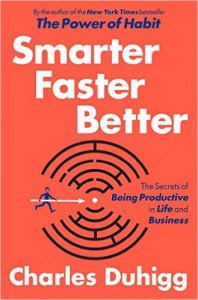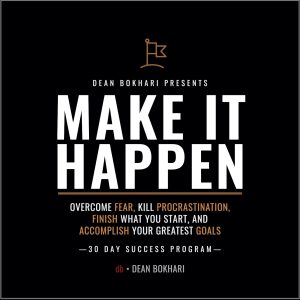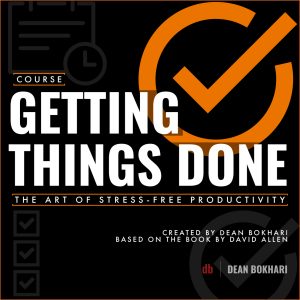
This is part II of our two-part series on goal setting, inspired by the book, Smarter Faster Better by Charles Duhigg.
In part I, we talked about why it’s important to think big and develop stretch goals if we want to achieve our personal and professional dreams.
But if all we do is dream big and write down long lists of audacious goals, we probably won’t take any action toward making them a reality...
And if we do get ourselves to take action, we probably won’t take enough of it.
We also probably won’t be consistent enough, for long enough, to achieve the results we desire.
Why? Because most of the time, it’s unclear what, specifically, we need to do in order to make those dreams a reality.
So, in this article and podcast episode, we’re going to focus on how to do that by pairing Stretch Goals with SMART Goals.
Start listening below, or keep scrolling to read…
Audio Version • #133: Stretch Goals + SMART Goals
Push Play below to listen in your browser • Listen on Apple Podcasts
Why pair Stretch goals with SMART goals?
The reason it’s important to combine stretch goals with SMART goals is because they serve two different–but equally important–purposes:
- Stretch goals inspire us to think big and remind us to focus on the big picture.
- SMART goals — goals that are Specific, Measurable, Achievable, Realistic, and Timebound — help us form a concrete plan of action in order to make the stretch goal a reality.
In Smarter Faster Better, Charles Duhigg tells us that the best way to do this is to put together a specific type of to-do list…
One that forces you to first figure out your stretch goal, and then to figure out your SMART-goal (aka: a specific action plan to help you achieve your big, giant stretch goal.
So the solution is writing to-do lists that pair stretch goals and SMART goals:
“Come up with a menu of your biggest ambitions. Dream big and stretch. Describe the goals that, at first glance, seem impossible, such as starting a company or running a marathon. Then choose one aim and start breaking it into short-term, concrete steps. Ask yourself: What realistic progress can you make in the next day, week, month? How many miles can you realistically run tomorrow and over the next three weeks? What are the specific, short-term steps along the path to bigger success? What timeline makes sense? Will you open your store in six months or a year? How will you measure your progress? Within psychology, these smaller ambitions are known as “proximal goals,” and repeated studies have shown that breaking a big ambition into proximal goals makes the large objective more likely to occur.”
Stretch first, get SMART later
Let’s go over the steps to put one of these Stretch + SMART Goal to-do lists together:
STEP 1: Start with a blank page, and write your long-term stretch goal at the top of that page.
STEP 2: Below that stretch goal, write your SMART goals related to your long-term stretch goal
Another way to think about this stretch + SMART goal combination is to think of stretch goals as projects and SMART goals as all the actions you need to take in order to complete the project.
Examples of Stretch goals paired with SMART goals
Here are a few examples of creating to-do lists that pair stretch goals + SMART goals together:
Stretch Goals + SMART Goals Example #1:
- Stretch goal: run marathon.
- Specific sub-goal: Run 7 straight miles without stopping.
- Measurable: Run twice around the park without walking.
- Achievable?: Yep, if I run 3 times a week.
- Realistic?: Yep, if I wake up early every Monday, Wednesday, and Friday.
- Timeline: Run 3 miles this week, 4 miles next week, 5 miles the week after that, 6 miles…
Stretch Goals + SMART Goals Example #2:
- Stretch goal: Research how to start an online business. (Remember: write this at the top of the page. Then, underneath your stretch goal, write down the details: the small tasks that tell you precisely what you need to do.)
- Specific: Register for business license at LegalZoom
- Timeline: By Tuesday.
Side note: It’s not even always important that you add every component of the SMART goal system, it’s just important that you’re constantly aware of what to do next while you’re also always reminding yourself of your larger ambition so you don’t get stuck in the weeds of doing things just for the sake of doing them.
Stretch Goals + SMART Goals Example #3:
- Stretch: Publish a kickass podcast episode on how to use stretch goals and SMART goals to succeed (in case you haven’t noticed, it’s this episode!)
- Specific: Come up with at least 3 examples of pairing stretch goals with SMART goals to help explain the concept; and then draft/outline/record an article and podcast episode.
- Measurable: Reference the book, Smarter Faster Better by Charles Duhigg and brainstorm ideas until I settle on three powerful examples I can utilize to clearly explain this concept.
- Achievable?: As long as I continue to stick with my usual schedule and time blocks to work on my most important goals and projects (like this article/podcast) then I should have this ready to go by Wednesday.
- Realistic?: Yep. Shouldn’t take more than 8 hours, split between two days, to do this from start to finish.
- Timeline:
- Monday (time block: 8am–12pm) — Focus on reading, research, brainstorming, writing and/or outlining both the article version as well as the podcast version of this project.
- Tuesday (time block: 8am–12pm) — Focus on reviewing and tweaking the final draft, recording the podcast, and then scheduling it for release on Monday morning.
BOOM.
Closing notes
How to Pair Stretch Goals with SMART Goals
“In short, we need stretch and SMART goals. It doesn’t matter if you call them by those names. It’s not important if your proximal goals fulfill every SMART criterion. What matters is having a large ambition and a system for figuring out how to make it into a concrete and realistic plan. Then, as you check the little things off your to-do list, you’ll move ever closer to what really matters. You’ll keep your eyes on what’s both wise and SMART.”
The difference between a person who sets big goals and fails to achieve them, and a person who sets big goals and makes them a reality, is a PLAN… Here’s how you can start putting one of your own together:
- Start with a stretch goal
- Next, pair that stretch goal with all of the SMART components related to completing it (Remember: first choose a BIG stretch goal that gets you inspired and excited—and then attach a SMART goal plan-of-attack to help you achieve it.)
- Step back every now and then to see the big picture. As Duhigg tells us in Smarter Faster Better, “In addition to having audacious ambitions and plans that are thorough, we still need, occasionally, to step outside the day-to-day and consider if we’re moving toward goals that make sense. We still need to think.”
- When you’re feeling down and need some inspiration—think about WHY you want to achieve the stretch goal.
- When you’re feeling lost, and don’t know what you need to do—it means you haven’t broken your stretch goal down into something actionable enough yet; so go back to step 2.
- Finally, stop reading this right now and take action. You can do it. Go!
Free Stretch Goal + SMART Goal template
If you’ve made it this far (without skipping) then you’ll probably love the Stretch Goal + SMART Goal template I’ve created for you.
It’s a downloadable PDF template that you can print out and fill in with your own stretch + SMART goals …
Oh, and did I mention it was free?
👇


 Free Course: Intro to The 7 Habits of Highly Effective People by Stephen Covey • Instructed by Dean Bokhari.
Free Course: Intro to The 7 Habits of Highly Effective People by Stephen Covey • Instructed by Dean Bokhari.
